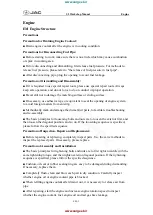
The best protection against carbon monoxide entry into
the vehicle body is a properly maintained engine exhaust
system.
Whenever a change is noticed in the sound of the exhaust
system, when exhaust fumes can be detected inside the
vehicle, or when the underside or rear of the vehicle is
damaged, have a competent mechanic inspect the com-
plete exhaust system and adjacent body areas for broken,
damaged, deteriorated, or mispositioned parts. Open
seams or loose connections could permit exhaust fumes
to seep into the passenger compartment. In addition,
inspect the exhaust system each time the vehicle is raised
for lubrication or oil change. Replace as required.
Safety Checks You Should Make Inside The Vehicle
Seat Belts
Inspect the belt system periodically, checking for cuts, frays,
and loose parts. Damaged parts must be replaced immedi-
ately. Do not disassemble or modify the system.
Front seat belt assemblies must be replaced after a
collision. Rear seat belt assemblies must be replaced after
a collision if they have been damaged (i.e., bent retractor,
torn webbing, etc.). If there is any question regarding belt
or retractor condition, replace the belt.
Air Bag Warning Light
The light should come on and remain on for four
to eight seconds as a bulb check when the igni-
tion switch is first turned ON. If the light is not lit
during starting, see your authorized dealer. If the
light stays on, flickers, or comes on while driving, have the
system checked by an authorized dealer.
Defroster
Check operation by selecting the defrost mode and place
the blower control on high speed. You should be able to feel
the air directed against the windshield. See your authorized
dealer for service if your defroster is inoperable.
2
THINGS TO KNOW BEFORE STARTING YOUR VEHICLE
95
Summary of Contents for 2014 Challenger SRT
Page 1: ...O W N E R S M A N U A L 2 0 1 4 Challenger SRT ...
Page 4: ......
Page 7: ...1 INTRODUCTION 5 ...
Page 10: ......
Page 100: ......
Page 136: ...134 UNDERSTANDING THE FEATURES OF YOUR VEHICLE ...
Page 137: ...3 UNDERSTANDING THE FEATURES OF YOUR VEHICLE 135 ...
Page 138: ...136 UNDERSTANDING THE FEATURES OF YOUR VEHICLE ...
Page 204: ......
Page 209: ...INSTRUMENT CLUSTER 4 UNDERSTANDING YOUR INSTRUMENT PANEL 207 ...
Page 281: ...4 UNDERSTANDING YOUR INSTRUMENT PANEL 279 ...
Page 352: ...350 STARTING AND OPERATING ...
Page 384: ......
Page 497: ...INDEX 10 ...
















































